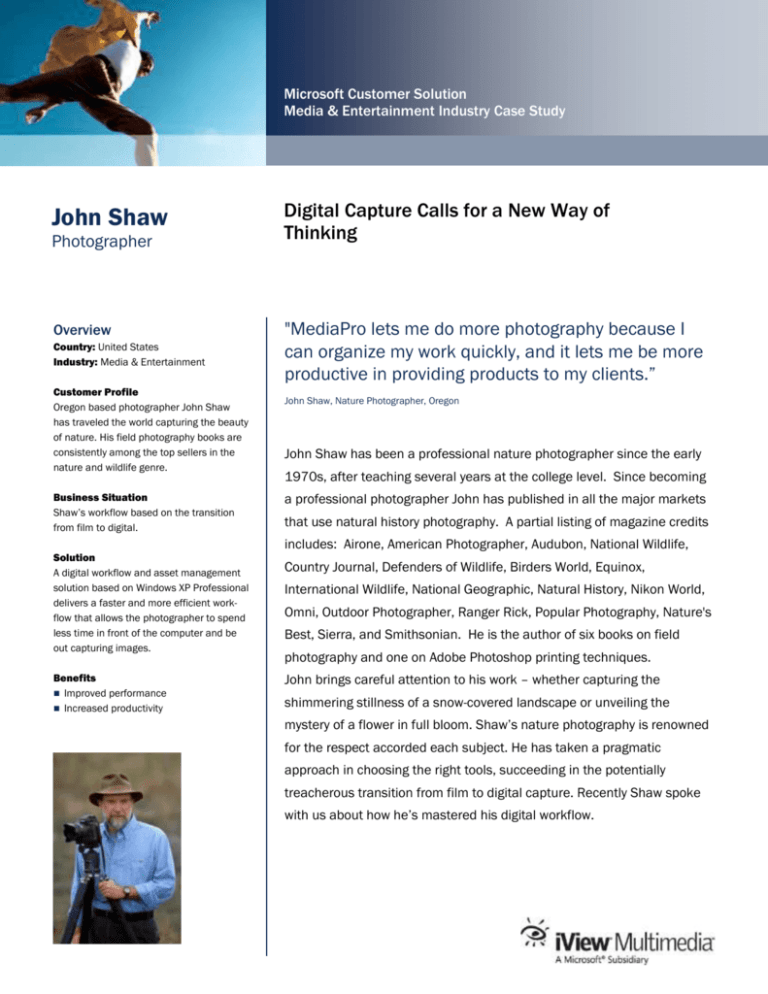
Microsoft Customer Solution
Media & Entertainment Industry Case Study
John Shaw
Photographer
Overview
Country: United States
Industry: Media & Entertainment
Customer Profile
Oregon based photographer John Shaw
has traveled the world capturing the beauty
of nature. His field photography books are
consistently among the top sellers in the
nature and wildlife genre.
Business Situation
Shaw’s workflow based on the transition
from film to digital.
Solution
A digital workflow and asset management
solution based on Windows XP Professional
delivers a faster and more efficient workflow that allows the photographer to spend
less time in front of the computer and be
out capturing images.
Benefits
Improved performance
Increased productivity
Digital Capture Calls for a New Way of
Thinking
"MediaPro lets me do more photography because I
can organize my work quickly, and it lets me be more
productive in providing products to my clients.”
John Shaw, Nature Photographer, Oregon
John Shaw has been a professional nature photographer since the early
1970s, after teaching several years at the college level. Since becoming
a professional photographer John has published in all the major markets
that use natural history photography. A partial listing of magazine credits
includes: Airone, American Photographer, Audubon, National Wildlife,
Country Journal, Defenders of Wildlife, Birders World, Equinox,
International Wildlife, National Geographic, Natural History, Nikon World,
Omni, Outdoor Photographer, Ranger Rick, Popular Photography, Nature's
Best, Sierra, and Smithsonian. He is the author of six books on field
photography and one on Adobe Photoshop printing techniques.
John brings careful attention to his work – whether capturing the
shimmering stillness of a snow-covered landscape or unveiling the
mystery of a flower in full bloom. Shaw’s nature photography is renowned
for the respect accorded each subject. He has taken a pragmatic
approach in choosing the right tools, succeeding in the potentially
treacherous transition from film to digital capture. Recently Shaw spoke
with us about how he’s mastered his digital workflow.
Situation
When Shaw shot with film, he used FileMaker
Pro to help him organize his files. Every image
had a unique file number and he could manage his slides that way. It was computer
intensive, but it worked.
Digital is different. While film was stored in a
physical location, digital file management
was a whole new ballgame. At first, Shaw
tried desktop file folders, using a hierarchical
schema with subfolders. However, that process became unwieldy too fast. Plus there
was no way to search. “It’s probably okay if
you have only a thousand images. The trouble is that once you get to 100,000 images,
it’s not okay.”
Maintaining the natural setting of
the image is a trademark of John
Shaw’s work.
“Before I started using iView MediaPro, my
workflow could best be described as, ‘total
chaos.’” Shaw had tried to replicate the process he used when he shot film. It took him a
while to realize that you need to think differently about digital files.
Shaw had specific requirements for his work,
so he began to look at many media management applications. Since he was shooting
RAW, Shaw needed something that would
allow him to archive RAW files, send clients
.TIF files and still do something on the Web
with .JPG files. He needed a tool that would
let him cross reference all those different file
formats. Shaw looked at databases or digital
filing systems. He even bought three or four
applications, but they were very user unfriendly — often more complicated than they
needed to be. The more he played with them
the less they made sense.
“I wasn’t sure that what I wanted existed, and
then I found iView MediaPro.”
Solution
Today Shaw rigorously applies the lessons
he’s learned to a disciplined workflow that
has reduced the time he needs to spend
organizing files — a potentially difficult and
time-consuming task. Running on Windows
XP Pro, the steps in his digital process are as
follows:
Download Files. Shaw uses Downloader Pro
from Breeze Systems to transfer RAW files
onto my computer. “I shoot with two identical
Nikon cameras, and I did not want to end up
with duplicate file names. Nikon solves that
problem – it lets you name your cameras.”
Downloader Pro renames his files as it downloads. It sorts files by date and automatically
makes a file folder for that date (whatever
the camera is set to). “One thing I remind my
students is to always be sure to reset the
date in your camera when you are traveling.”
Name Files. Shaw can’t emphasize the importance of a file naming system enough.
“You must begin with a consistent naming
convention. You should use a name sequence that makes sense to you. You don’t
want names to be too long because they can
become unwieldy.” For Shaw, the file extension is useful in identifying what the image is.
For example, his original file is a .DNG (Adobe
Digital Negative file), and he can tell from its
name that it has not been processed in Photoshop. Those ending with .PSD have been
processed in Photoshop. He knows that if it’s
.TIF then it’s been flattened, sharpened and
sized to go to a client. A .JPG is in use for
email or the Web. But in all cases, the first
part of the file name is always the same.
Shaw also assigns a job code which identifies
the shoot. “Recently I was on a shoot in Kenya, so I assigned the name of the shoot and
Downloader Pro automatically made a file
folder called Kenya; then it sorted all the files
by day and time in the Kenya file folder.”
Shaw’s procedure is to name a file by a 6digit date (YYMMDD) then an underscore,
then the three-letter code for the camera (he
shoots with two identical Nikons, so this
keeps things organized). Then the camera
assigns a sequential file number. An actual
file name might be 061025_JSP1234.nef.
Shaw’s cameras are named JSP (for John
Shaw Photography) and NIK (for Nikon).
Select Files. For editing, Shaw uses Adobe
Bridge. It’s pretty simple. He asks himself,
“Do I want to keep this or throw it away? Yes
or No?” He edits pretty ruthlessly.
Shaw has travelled the globe
capturing beautiful landscapes
and documenting natural history.
“MediaPro was the first
program that I looked at
which was logically
organized, easy to learn
software. The more I use
it, the more I realize how
powerful the program is.
And it’s extremely quick,
even on my laptop.”
John Shaw
Convert RAW Files. Shaw first converts his
RAW files into the DNG format. “I’m a firm
believer that DNG will become the industry
standard. Not only does it give you flexibility,
but DNG stores all the information within the
file itself, instead of storing it as a sidecar
which could get separated from the original
file. Another good thing about DNG is it takes
up less room (1/3 less space) on the hard
drive.”
then when he gets back to the office, he can
embed those captions into the files.
For Shaw the application is unlimited in the
ways you can organize catalogs. He can make
virtual catalog sets. He can sort and crossorganize anyway he wants to. “I have never
seen another digital database that would let
me do this. Others would not let me cross
index without a lot of work.” With MediaPro,
it’s drag and drop. There is no need to copy,
move or sort. All Shaw has to do is move the
thumbnails in MediaPro – it’s great. It’s also
very easy to move whole collections of
thumbnails.
Correct RAW Files. Shaw makes his corrections in Adobe Camera Raw. “It's important
to me to do this first, because I get a good
preview image embedded in the .DNG file. I
can use this preview image later, for example
when making my web gallery for agency submission.”
Distribute Assets. One of the stock photo
agencies Shaw works with is in England. “I
used to send slides. That’s so very “old
school” now. Today, using MediaPro, I can
make a Web page in minutes once everything
is converted to .DNG; so captions go on the
Web page and the file name appears under
each one. I post the .DNG files and let my
agent or client tell me whether or not they
want it before I put more work into it in Photoshop. That time savings is an extra benefit
of MediaPro that I believe is often overlooked.”
Edit selected files. Shaw then uses Adobe
Photoshop to fine-tune images that he has
selected; and saves them as Photoshop Document (.PSD) files. For the sake of housekeeping, he keeps DNG and PSD files are on
separate drives because the drives get filled
up quickly. “I'll always have a lot more .DNG
files than finished .PSD ones. Mixing them
together would make it more difficult when I
backup -- or it I ever needed to restore my
system.”
Archive. Shaw has a catalog for each of his
external 250 or 300 GB hard drives. Each
drive is dated with what he shot. He also has
a giant master catalog of all these separate
catalogs. This master permits Shaw to easily
reference his entire library of images. “The
more you publish the more you will publish,
so be prepared by using a unique inventory
name. When I send files to clients I add them
to a master database of what I’ve got. I keep
track of what’s been bought.”
Manage Assets. At this point, Shaw imports
all of his files into iView MediaPro, both DNG
and PSD. There are several major benefits to
MediaPro. First, you can work offline. Shaw
does all my captioning in MediaPro, because
it’s simple. He can do it while he’s on a plane;
Benefits
Busy with traveling around the globe on photo
tours and assignments, Shaw is making full
use of his high-performance digital imaging
system running Windows XP Professional. “I
am able to exercise more control over my
For More Information
For more information about Microsoft
products and services, call the Microsoft
Sales Information Center at (800) 4269400. In Canada, call the Microsoft Canada Information Centre at (877) 568-2495.
Customers who are deaf or hard-of-hearing
can reach Microsoft text telephone
(TTY/TDD) services at (800) 892-5234 in
the United States or (905) 568-9641 in
Canada. Outside the 50 United States and
Canada, please contact your local Microsoft subsidiary. To access information
using the World Wide Web, go to:
www.microsoft.com
For more information about John Shaw’s
work, visit his Web site at:
www.johnshawphoto.com
Microsoft Solutions for the Media &
Entertainment Industry
images, am better able to find just the image
I need when I need it, and I have a seamless
experience between the field and my studio.”
“I appreciate the fact that I can work offline.
From my desktop, I copy a catalog to my laptop and refine it. Then, I take that catalog and
replace it on my desktop. I’m always refining
my catalogs.”
Creative professionals and digital media
companies are under tremendous pressure
to deliver effective, high quality results to
clients in less time than ever before. Workflow efficiency and the ability to rapidly iterate
through the design/edit/proof phases of a
project are fundamental to success. To help
meet these challenges, Microsoft and its
partners are working together to provide a
range of high-powered digital media and content solutions based on the Windows XP Professional operating system. Whether your
creative work involves music, video, graphic
design or still photography, solutions built on
Windows XP enable you to do get your creative work done in less time and with higher
quality results than ever before.
Given Shaw’s tight schedule and amount of
travel, he really appreciates software solutions that are easy to use and that can reduce his time in front of the computer. “I’m
happy to think that MediaPro will be around
for a long time. The program has been a true
asset – such a well-designed piece of software, very intuitive and you don’t have to
spend days learning it, you can just jump in.”
For more information about professional
digital photography using Microsoft Windows
XP, go to:
www.microsoft.com/prophoto
For more information about iView MediaPro
go to:
www.iviewmultimedia.com
Software and Services
© 2006 Microsoft Corporation. All rights reserved. This case
study is for informational purposes only. MICROSOFT MAKES NO
WARRANTIES, EXPRESS OR IMPLIED, IN THIS SUMMARY.
Microsoft, Windows, and the Windows logo are either registered
trademarks or trademarks of Microsoft Corporation in the
United States and/or other countries. The names of actual
companies and products mentioned herein may be the trademarks of their respective owners.
Photographs © John Shaw. Used with permission.
Document published October 2006
Microsoft Windows XP Professional
Microsoft Office Professional 2003
iView MediaPro
Adobe Photoshop CS2
Breeze Systems Downloader Pro
Hardware
Dell XPS desktop
Dell XPS and Sony VAIO laptops
Epson Stylus Pro printers









